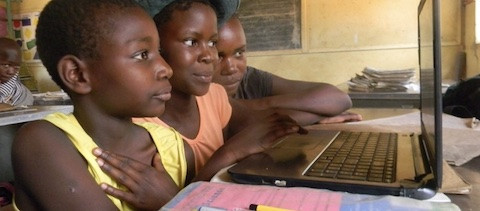
GCED Basic Search Form
Quick Search
You are here
News

Computer science? That’s boy stuff. Or so Hesme, aged 15, believed when she switched schools in 10th grade. “I thought I’d be terrible at it”, she says. Her former school in Durban, on the coast of South Africa, didn’t offer comprehensive science, technology, engineering or math (STEM) classes.
When she moved to Curro Heritage House High School, STEM classes were a regular part of the curriculum. She was nervous about that – but when her brother dared her to take a computer science class, she accepted the challenge to prove him wrong.
Hesme loved her computer science class. “It became my passion”, she says now, in her final year of high school. As the only girl in the class, at first, she felt intimidated but ended up thriving.
The COVID-19 pandemic has exposed a deep-rooted gender digital divide as a number of countries are increasingly moving to distance and hybrid learning solutions, most often leaving girls behind in their education paths. In a context where 2 billion women are offline, contributions from half of the world’s population will continue to be left out if these gaps are not closed and more girls are empowered to leave their digital footprint.
You can’t be what you don’t see
A critical first step is to expose girls to positive female role models in STEM fields. Girls who know a woman in a STEM profession are significantly more likely to feel confident when doing STEM coursework (61%) than those who don’t know a woman in a STEM profession (44%).
When asked to describe a typical scientist, engineer, mathematician or programmer, 30% of girls sketch out male personas. Even adult women do the same (40%) — including 43% of the women who work in STEM themselves.
UNESCO works to engage female role models, including teachers, to close digital and STEM gaps in the classroom through initiatives such as YouthMobile, which was mobilised to support this virtual AI Hackathon.
“We don’t have older girls showing that they are capable”, says Karla, a senior from the High School of Math and Natural Sciences, in Osijek, Croatia, a small town on the Drava River. Her team placed third in the hackathon. Perhaps they exist, she says, but “they’re not speaking up about it, and showing the rest of us what they are doing”.
Curtailing girls’ education ultimately impacts the entire world. In an era when jobs increasingly require digital skills, educating girls can boost local and regional economies and fight poverty. But it’s not happening fast enough.
A Hackathon as an intervention to interest girls in AI
The all-girls edition of Imagine Cup Junior virtual AI hackathon held by Microsoft and UNESCO, under the theme AI for Earth, engaged girls aged 14-18 in designing artificial intelligence solutions to respond to global challenges and in particular, save a species.
When the call to try out for an all-girls artificial intelligence (AI) hackathon came out, Hesme immediately began writing the application letter. “I was just sitting in class, writing, and all my passion came out”, she says.
Soon after, she received good news: Hesme was chosen to be on a five-girl team representing South Africa.
During the two-day virtual event, Hesme and other girls attended talks from women in STEM fields and participated in hands-on workshops. They worked together on practical exercises designed to teach them how AI could be used to solve real-world problems using AI prediction modelling and techniques, such as decision trees and random decision forests.
Hesme and her team won second place for their AI solution aiming to save African wild dogs – a species endangered by habitat loss, disease, predator hunting, and humans.
“AI captured my heart”, says Hesme, whose team competed against 16 others from 11 countries across Europe, Africa and the Middle East.
Impact: the tech appeal for girls
In 2018, Microsoft commissioned research to investigate girls’ attitudes toward STEM, expecting negative results. “But surprisingly, we found that actually they were quite positive about STEM and technology,” says Alexa Joyce, Microsoft’s Future-Ready Skills Director, who answered questions and shared advice during the hackathon for girls looking to change the world through AI.
“Typically, you hear, ‘Oh, girls think technology is hard or boring.’”, she says. Instead, girls were clearly interested in using technology to be creative and address issues that would impact the world. It was the application of the technology — not the technology itself — that fascinated them.
Today, Hesme is developing her own AI-based app to help people like herself — diagnosed as being on the autism spectrum — to better cope when interacting with the world. She plans to get a higher-level certificate in AI next year before going on to study computer science at university.
The gender gap in education is serious. More than 130 million girls were already being denied education before COVID-19 hit. And as schools around the world closed, UNESCO estimated that 11 million additional girls are at risk of never going back to school.
UNESCO partnered with Microsoft on the hackathon under UNESCO’s Global Education Coalition’s Gender Flagship which unites more than 70 institutions from the United Nations, civil society, academia and the private sector to generate solutions to help minimize the effects of COVID-19 on education and gender equality.
- Read the original version of the article on Microsoft’s website
- More on the hackathon: Girls design artificial intelligence solutions during virtual hackathon held by Microsoft and UNESCO
- Keeping girls in the picture campaign
- UNESCO’s work on gender equality in education
Photo: CECIL BO DZWOWA/Shutterstock.com
URL:
